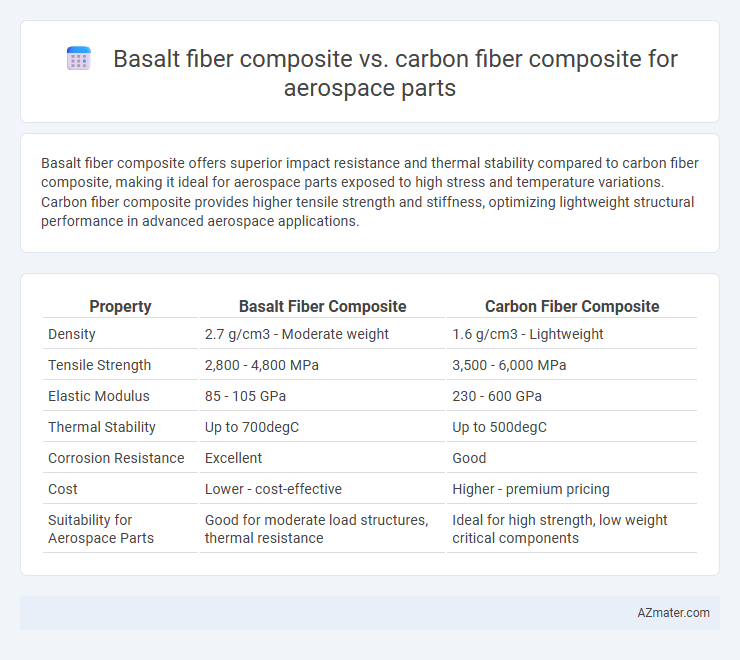Basalt fiber composite offers superior impact resistance and thermal stability compared to carbon fiber composite, making it ideal for aerospace parts exposed to high stress and temperature variations. Carbon fiber composite provides higher tensile strength and stiffness, optimizing lightweight structural performance in advanced aerospace applications.
Table of Comparison
| Property | Basalt Fiber Composite | Carbon Fiber Composite |
|---|---|---|
| Density | 2.7 g/cm3 - Moderate weight | 1.6 g/cm3 - Lightweight |
| Tensile Strength | 2,800 - 4,800 MPa | 3,500 - 6,000 MPa |
| Elastic Modulus | 85 - 105 GPa | 230 - 600 GPa |
| Thermal Stability | Up to 700degC | Up to 500degC |
| Corrosion Resistance | Excellent | Good |
| Cost | Lower - cost-effective | Higher - premium pricing |
| Suitability for Aerospace Parts | Good for moderate load structures, thermal resistance | Ideal for high strength, low weight critical components |
Introduction to Fiber Composites in Aerospace
Fiber composites in aerospace combine high strength-to-weight ratios with corrosion resistance, critical for reducing aircraft weight and improving fuel efficiency. Basalt fiber composites offer exceptional thermal stability and cost-effectiveness, while carbon fiber composites provide superior stiffness and tensile strength, essential for structural aerospace components. Selection between basalt and carbon fibers depends on performance requirements, environmental conditions, and budget constraints in aerospace manufacturing.
Material Composition: Basalt Fiber vs Carbon Fiber
Basalt fiber composites consist of natural volcanic basalt rock fibers, offering high tensile strength and excellent thermal resistance, while carbon fiber composites are made from carbon atoms arranged in a crystalline structure, providing superior stiffness and lightweight properties. Basalt fibers exhibit enhanced impact resistance and corrosion resistance compared to carbon fibers, which excel in modulus of elasticity and fatigue resistance. The material composition differences influence aerospace applications by balancing cost-effectiveness and mechanical performance, with basalt fibers serving as a more environmentally friendly alternative to carbon fiber composites.
Mechanical Properties Comparison
Basalt fiber composites exhibit higher tensile strength than carbon fiber composites, typically around 2800 MPa compared to 2400 MPa, offering enhanced impact resistance and better fatigue durability in aerospace applications. Carbon fiber composites dominate in stiffness with a tensile modulus up to 230 GPa, surpassing basalt fibers which generally achieve around 90 GPa, making carbon fiber ideal for load-bearing structural components. The superior thermal stability and corrosion resistance of basalt fiber composites provide advantages in harsh aerospace environments, while carbon fiber composites maintain a lower density, contributing to overall weight reduction in high-performance aircraft parts.
Weight and Density Analysis
Basalt fiber composites offer a density of approximately 2.7-2.9 g/cm3, making them slightly heavier than carbon fiber composites, which typically have densities around 1.6 g/cm3. The lower density of carbon fiber composites translates to significant weight savings, enhancing fuel efficiency and payload capacity in aerospace applications. Despite their higher weight, basalt fiber composites provide excellent vibration damping and cost advantages but remain less favorable when strict weight constraints are critical.
Thermal Performance and Resistance
Basalt fiber composites exhibit superior thermal stability with continuous use temperatures reaching up to 650degC, making them highly resistant to thermal degradation compared to carbon fiber composites, which typically withstand temperatures around 400-600degC depending on the resin matrix. Basalt fibers also demonstrate enhanced resistance to thermal shock and oxidation without requiring additional coatings, whereas carbon fiber composites may suffer from oxidation and require protective measures in high-temperature aerospace environments. The combination of high thermal resistance and cost-effectiveness positions basalt fiber composites as a promising alternative to carbon fiber composites for aerospace components exposed to extreme thermal conditions.
Durability and Fatigue Life
Basalt fiber composites demonstrate superior durability in aerospace parts due to their excellent resistance to high-temperature corrosion and chemical degradation compared to carbon fiber composites. Fatigue life of basalt fiber composites tends to exceed that of carbon fiber composites by offering enhanced crack resistance and energy absorption under cyclic loading conditions. These properties make basalt fiber composites a promising alternative for aerospace applications requiring long-term structural reliability.
Cost Comparison: Production and Lifecycle
Basalt fiber composites offer a significant cost advantage over carbon fiber composites in aerospace applications due to lower raw material expenses and simpler manufacturing processes, reducing production costs by approximately 20-30%. In lifecycle analysis, basalt composites demonstrate enhanced durability and corrosion resistance, which lowers maintenance and replacement costs compared to carbon fiber composites, despite carbon fibers providing higher strength-to-weight ratios. The combined savings in production and extended service life position basalt fiber composites as a more economical choice for certain aerospace components where cost efficiency and sufficient performance are critical.
Environmental Impact and Sustainability
Basalt fiber composites offer a more environmentally sustainable alternative to carbon fiber composites due to their natural origin, lower energy consumption in production, and increased recyclability potential. The production of basalt fibers generates fewer greenhouse gas emissions and utilizes abundant volcanic rock, reducing reliance on non-renewable petroleum-based materials characteristic of carbon fiber manufacturing. These attributes make basalt fiber composites a preferable choice for aerospace applications aiming to minimize ecological footprint without compromising performance.
Application Suitability in Aerospace
Basalt fiber composites offer excellent thermal stability, corrosion resistance, and impact absorption, making them suitable for aerospace components exposed to harsh environmental conditions. Carbon fiber composites provide superior strength-to-weight ratio and stiffness, essential for structural aerospace parts requiring high load-bearing capacity and reduced weight. Selection between basalt and carbon fiber composites depends on specific aerospace applications where trade-offs between durability, cost, and mechanical performance are critical.
Future Trends in Aerospace Composite Materials
Basalt fiber composites offer a sustainable and cost-effective alternative to carbon fiber composites, with enhanced impact resistance and excellent thermal stability, crucial for next-generation aerospace components. Emerging trends indicate increased integration of hybrid composites combining basalt and carbon fibers to optimize strength-to-weight ratios and improve damage tolerance in aerospace parts. Advancements in resin systems and manufacturing techniques are driving the adoption of these materials, targeting lighter, more durable, and environmentally friendly aerospace structures.

Infographic: Basalt fiber composite vs Carbon fiber composite for Aerospace part
 azmater.com
azmater.com